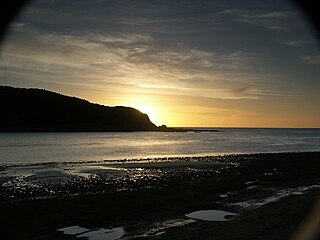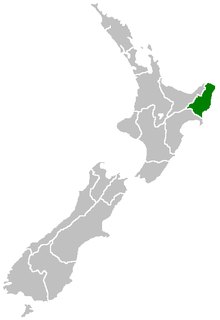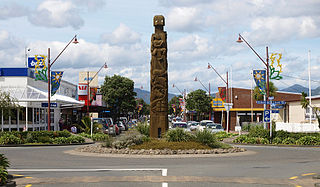
Ngāi Tahu, or Kāi Tahu, is the principal Māori iwi (tribe) of the southern region of New Zealand. Its takiwā is the largest in New Zealand, and extends from Blenheim, Mount Mahanga and Kahurangi Point in the north to Stewart Island in the south. The takiwā comprises 18 rūnanga corresponding to traditional settlements.

Ngāti Toa, Ngāti Toarangatira or Ngāti Toa Rangatira, is a Māori iwi (tribe) in the lower North Island and upper South Island of New Zealand. Its rohe extends from Whanganui in the north, Palmerston North in the east, and Kaikoura and Hokitika in the south. Ngāti Toa remains a small iwi with a population of only about 4500. It has four marae: Takapūwāhia and Hongoeka in Porirua, and Whakatū and Wairau in the north of the South Island. Ngāti Toa's governing body has the name Te Rūnanga o Toa Rangatira.

Ngāi Te Rangi or Ngāiterangi is a Māori iwi, based in Tauranga, New Zealand. Its rohe extends to Mayor Island / Tuhua and Bowentown in the north, to the Kaimai Range in the west, south of Te Puke and to Maketu in the east.

Ngāi Tūhoe, often known simply as Tūhoe, is a Māori iwi ("tribe") of New Zealand. It takes its name from an ancestral figure, Tūhoe-pōtiki. The word tūhoe literally means "steep" or "high noon" in the Māori language. Tūhoe people also bear the sobriquet Nga Tamariki o te Kohu. Tūhoe traditional land is at Te Urewera in the eastern North Island, a steep, heavily forested area which includes Lake Waikaremoana. Tūhoe traditionally relied on the forest for their needs. The tribe had its main centres of population in the small mountain valleys of Ahikereru and Ruatahuna, with Maungapohatu, the inner sanctum of the Urewera, as their sacred mountain. The Tūhoe country had a great reputation among the neighbouring tribes as a graveyard for invading forces.

"Ka Mate" is a Māori haka composed by Te Rauparaha, war leader of the Ngāti Toa tribe of the North Island of New Zealand.
Mātaatua was one of the great voyaging canoes by which Polynesians migrated to New Zealand, according to Māori tradition. Māori traditions say that the Mātaatua was initially sent from Hawaiki to bring supplies of kūmara to Māori settlements in New Zealand. The Mātaatua was captained by Toroa, accompanied by his brother, Puhi; his sister, Muriwai; his son, Ruaihona; and daughter, Wairaka.
Nukutere was one of the Māori migration canoes that brought Polynesian migrants to New Zealand. Nukutere is one of the lesser known canoes. However, the descendants of the Nukutere migrants can be found in Ngāi Tūhoe, Ngāti Porou and in other eastern Bay of Plenty iwi.
The Māori protest movement is a broad indigenous-rights movement in Aotearoa New Zealand. While this movement has existed since Europeans first colonised New Zealand, its modern form emerged in the early 1970s and has focused on issues such as the Treaty of Waitangi, Māori land rights, the Māori language and culture, and racism. It has generally been allied with the left wing although it differs from the mainstream left in a number of ways. Most members of the movement have been Māori but it has attracted some support from pākehā (non-Māori) New Zealanders and internationally, particularly from other indigenous peoples. Notable successes of the movement include establishment of the Waitangi Tribunal, the return of some Māori land, and the Māori language being made an official language of New Zealand. The movement is part of a broader Māori Renaissance.

Ngāi Tāmanuhiri is a Māori iwi of New Zealand. They were formerly known as Ngai Tahupo after Porourangi's younger brother, the eponymous ancestor Tahu Potiki the eponymous ancestor of the Kai Tahu iwi of Te Waipounamu.

Rongowhakaata is a Māori iwi of the Gisborne region of New Zealand.
Te Tai Rawhiti or "the east side" was one of the five new New Zealand parliamentary Māori electorates created in 1996 for MMP. It was largely replaced in 1999 with Waiariki and Ikaroa-Rāwhiti.
Te Wharekura o Ruatoki is a school in the Eastern Bay of Plenty, New Zealand, serving children, years 1 through 13. It was established in 1896 after a visit by Richard Seddon and James Carroll

Te Matatini is a national Māori performing arts festival in which kapa haka performers from all around Aotearoa compete in the Te Matatini festival. The name was given by Professor Wharehuia Milroy, a composite of Te Mata meaning the face and tini denoting many — hence the meaning of Te Matatini is many faces.
Turuhira Hare is a Māori academic of performing arts, composition and education. She is of Tūhoe, Te Arawa and English and Scottish descent and is a daughter of the late renowned Tūhoe kaumātua, Te Uruhina McGarvey. She is a leading figure in her community and is renowned for her contribution to the arts of kapa haka and education.
Te Tapuwae is a Māori cemetery located close to Otenuku Marae in Ruatoki, in the Bay of Plenty Region of New Zealand. It is where tribal leaders of the Ngai Tuhoe iwi are traditionally buried, most notably chief Tamarau Takurua.
Takurua Tamarau, (1871–1958), was a notable New Zealand tribal leader, shearer, farmer and Ringatū healer. Of Māori descent, he is identified with the Tuhoe iwi. Tamarau was born at Kohimarama, Bay of Plenty, New Zealand in c. 1871.
William Te Rangiua (Pou) Temara is a Māori academic. He is currently professor of Te Reo, Tikanga and philosophy at Waikato University and a cultural authority on whaikōrero (oratory), whakapapa (genealogy) and karakia. Prior to working at Waikato he taught at Victoria University of Wellington and Te Whare Wānanga o Awanuiārangi.

Te Whakaruruhau o Ngā Reo Irirangi Māori is a New Zealand radio network consisting of radio stations that serve the country's indigenous Māori population. Most stations receive contestable government funding from Te Māngai Pāho, the Māori Broadcast Funding Agency, to operate on behalf of affiliated iwi (tribes) or hapū (sub-tribes). Under their funding agreement, the stations must produce programmes in the Māori language, and must actively promote Māori culture.

Whakatōhea is a Māori iwi located in the eastern Bay of Plenty region of New Zealand. The iwi comprises six hapu: Ngāi Tamahaua, Ngāti Ira, Ngāti Ngahere, Ngāti Patumoana, Ngāti Ruatākena and Ūpokorehe. In the 2006 Census, 12,072 people claimed an affiliation with Whakatōhea.









